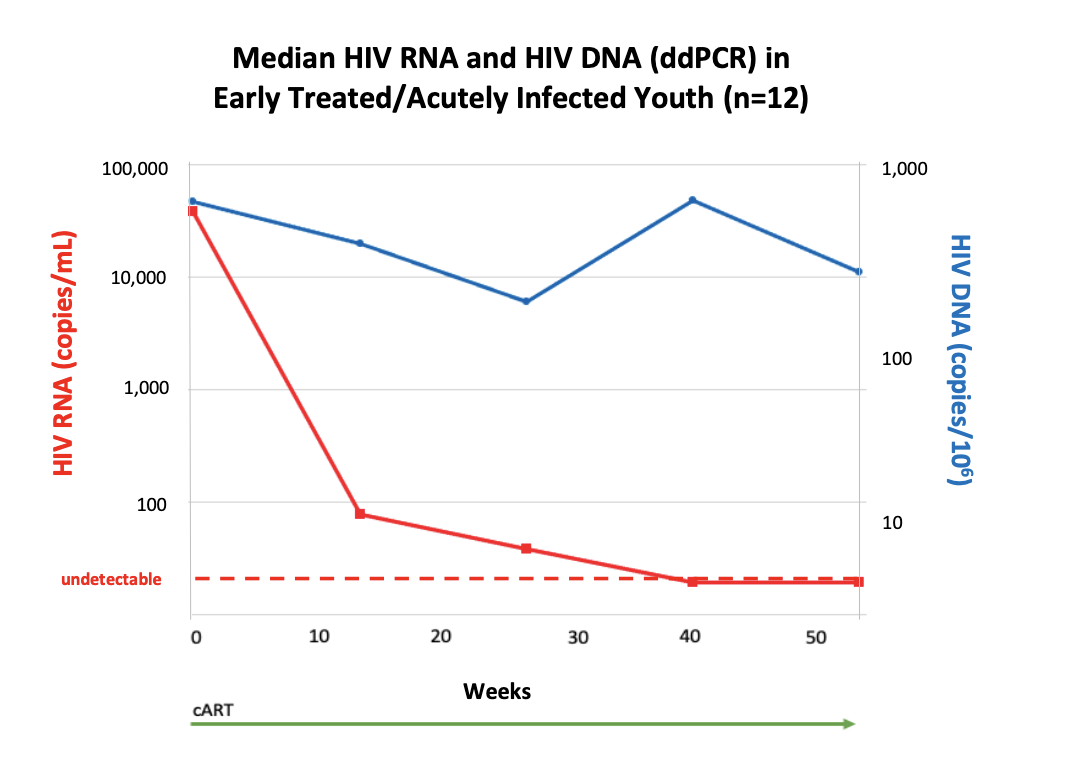Infectious Diseases
Category: Abstract Submission
Infectious Diseases: Potpourri
548 - Longitudinal Immune and Inflammatory Marker Responses In Acutely/Recently HIV Infected Youth After Early Combination Antiretroviral Treatment
Sunday, April 24, 2022
3:30 PM - 6:00 PM US MT
Poster Number: 548
Publication Number: 548.328
Publication Number: 548.328
Jonathan Hu, University of California, Los Angeles David Geffen School of Medicine, Walnut, CA, United States; Jamie Hsu, University of California, Los Angeles David Geffen School of Medicine, Rancho Cucamonga, CA, United States; Catherine Zhang, University of California, Los Angeles David Geffen School of Medicine, Stockton, CA, United States; Adriana Muro, University of California, Los Angeles David Geffen School of Medicine, Lakewood, CA, United States; Pawan Pathagamage, University of California, Los Angeles David Geffen School of Medicine, Irvine, CA, United States; Karin Nielsen-Saines, University of California, Los Angeles David Geffen School of Medicine, Los Angeles, CA, United States; Tara Kerin, University of California, Los Angeles David Geffen School of Medicine, Los Angeles, CA, United States; Ruth Cortado, University of California, Los Angeles David Geffen School of Medicine, Los Angeles, CA, United States; yvonne J. bryson, University of California, Los Angeles David Geffen School of Medicine, Los Angeles, CA, United States

Jonathan Hu, BS
Medical Student
Department of Pediatrics, University of California, Los Angeles David Geffen School of Medicine
Walnut, California, United States
Presenting Author(s)
Background: Early initiation of combination antiretroviral therapy (cART) has been shown to reduce HIV reservoir size, slow viral replication, and facilitate drug free remission in acutely infected adult populations. However, little is known of early cART outcomes in acutely HIV-infected adolescents. Variations in immune profile, such as immune pliability due to an active thymus may potentiate greater benefits from prompt cART.
Objective: We report viral and inflammatory/immune dysregulation biomarkers in acute/recently infected youth who received early cART over 1 year.
Design/Methods: We assessed the first 12 participants enrolled in the Adolescent Trials Network 147 study with a 12-month (mo) follow up. All were drug naive male MSM (mean age 20 y/o, 85% Black/Hispanic) who promptly initiated cART. Visits at baseline (B/L), 4, 8, and 12 mo included HIV RNA PCR, digital droplet DNA (ddPCR), T-cell flow cytometry, and Luminex assays. Fiebig staging and acute/recent infection status was assessed via HIV-1 4th gen Western Blot (WB).
Results: At B/L, 4 participants were Fiebig stage V (acute) and 8 were VI (recent). Median HIV viral load (VL) and DNA reservoir was 37,827 copies (cp)/ml and 628 cp/10^6 at B/L, respectively. At one year, there was a significant reduction (99%) in HIV RNA ( < 20 cp/ml, p ≤ 0.05) and 58% reduction in DNA (267 cp/10^6). WB results were positive for 10 (83%) and indeterminate for 2 youth (17%) at B/L. At 12 mo, HIV-1 antibodies were reduced to 2 (17%) positive, 8 (67%) indeterminate, and 2 (17%) negative immunoblots. Flow cytometry showed a 50% rebound in mean CD4 percentages (28% B/L vs 40% 12mo, p ≤ 0.05) and 82% increase in mean CD4:CD8 ratio (0.48 B/L vs 0.87 12mo, p ≤ 0.05). Mean surface markers CD38+HLA-DR+CD8+ and PD1+CD8+ decreased by 60% (48 B/L vs 19 12mo, p ≤ 0.05) and 47% (40 B/L vs 21 12mo, p ≤ 0.05) at one year, respectively. In participants with available Luminex data, inflammatory biomarker CXCL13 was elevated at B/L (312 pg/mL) and decreased over time.Conclusion(s): Early cART led to rapid viral suppression in most youth by 6 mo persisting through 12 mo. By one year, HIV-1 antibody WBs were indeterminate or negative in 10 youth (83%). CD4+ T-cells and CD4:CD8 ratios significantly rebounded to normal with concurrent reductions in T-cell activation and dysregulation markers. Youth who received potent cART early in acute/recent infection have suppressed viremia and lower viral reservoirs, which may mitigate chronic immune dysfunction with improved long term disease prognosis compared to those who initiate ARV later.
Median HIV RNA and HIV DNA (ddPCR) In Early Treated/Acutely Infected Youth (n=12) 12 acutely/recently infected adolescents were enrolled and immediately started on cART. They were followed for one year and underwent periodic testing. Median HIV RNA viral load decreased by 99%, from 37,827 cp/ml to < 20 cp/ml, by one year. HIV DNA reservoir also decreased by 58%, from 268 cp/10^6 to 267 cp/10^6, by one year.
12 acutely/recently infected adolescents were enrolled and immediately started on cART. They were followed for one year and underwent periodic testing. Median HIV RNA viral load decreased by 99%, from 37,827 cp/ml to < 20 cp/ml, by one year. HIV DNA reservoir also decreased by 58%, from 268 cp/10^6 to 267 cp/10^6, by one year.
Objective: We report viral and inflammatory/immune dysregulation biomarkers in acute/recently infected youth who received early cART over 1 year.
Design/Methods: We assessed the first 12 participants enrolled in the Adolescent Trials Network 147 study with a 12-month (mo) follow up. All were drug naive male MSM (mean age 20 y/o, 85% Black/Hispanic) who promptly initiated cART. Visits at baseline (B/L), 4, 8, and 12 mo included HIV RNA PCR, digital droplet DNA (ddPCR), T-cell flow cytometry, and Luminex assays. Fiebig staging and acute/recent infection status was assessed via HIV-1 4th gen Western Blot (WB).
Results: At B/L, 4 participants were Fiebig stage V (acute) and 8 were VI (recent). Median HIV viral load (VL) and DNA reservoir was 37,827 copies (cp)/ml and 628 cp/10^6 at B/L, respectively. At one year, there was a significant reduction (99%) in HIV RNA ( < 20 cp/ml, p ≤ 0.05) and 58% reduction in DNA (267 cp/10^6). WB results were positive for 10 (83%) and indeterminate for 2 youth (17%) at B/L. At 12 mo, HIV-1 antibodies were reduced to 2 (17%) positive, 8 (67%) indeterminate, and 2 (17%) negative immunoblots. Flow cytometry showed a 50% rebound in mean CD4 percentages (28% B/L vs 40% 12mo, p ≤ 0.05) and 82% increase in mean CD4:CD8 ratio (0.48 B/L vs 0.87 12mo, p ≤ 0.05). Mean surface markers CD38+HLA-DR+CD8+ and PD1+CD8+ decreased by 60% (48 B/L vs 19 12mo, p ≤ 0.05) and 47% (40 B/L vs 21 12mo, p ≤ 0.05) at one year, respectively. In participants with available Luminex data, inflammatory biomarker CXCL13 was elevated at B/L (312 pg/mL) and decreased over time.Conclusion(s): Early cART led to rapid viral suppression in most youth by 6 mo persisting through 12 mo. By one year, HIV-1 antibody WBs were indeterminate or negative in 10 youth (83%). CD4+ T-cells and CD4:CD8 ratios significantly rebounded to normal with concurrent reductions in T-cell activation and dysregulation markers. Youth who received potent cART early in acute/recent infection have suppressed viremia and lower viral reservoirs, which may mitigate chronic immune dysfunction with improved long term disease prognosis compared to those who initiate ARV later.
Median HIV RNA and HIV DNA (ddPCR) In Early Treated/Acutely Infected Youth (n=12)
 12 acutely/recently infected adolescents were enrolled and immediately started on cART. They were followed for one year and underwent periodic testing. Median HIV RNA viral load decreased by 99%, from 37,827 cp/ml to < 20 cp/ml, by one year. HIV DNA reservoir also decreased by 58%, from 268 cp/10^6 to 267 cp/10^6, by one year.
12 acutely/recently infected adolescents were enrolled and immediately started on cART. They were followed for one year and underwent periodic testing. Median HIV RNA viral load decreased by 99%, from 37,827 cp/ml to < 20 cp/ml, by one year. HIV DNA reservoir also decreased by 58%, from 268 cp/10^6 to 267 cp/10^6, by one year.